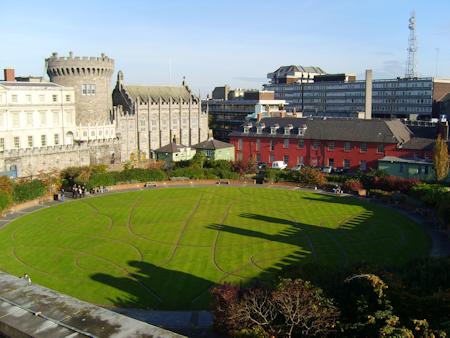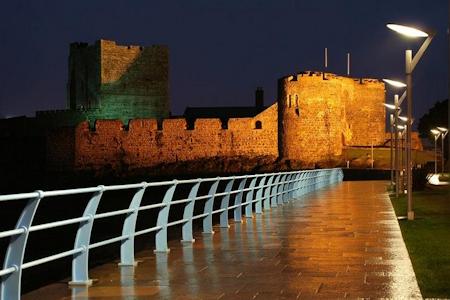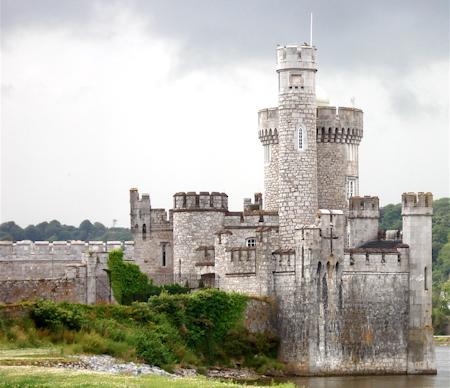
Castles in Ireland
Ireland possesses many castles and tower houses and they are by far the most common buildings of antiquity found in the country. Most of them are actually fortified houses dating from the fifteenth, sixteenth and seventeenth centuries.
Castles first appeared in Ireland with the arrival of the Anglo-Normans in the 12th Century. In 1169 the ousted King of Leinster, Dermot MacMurrogh, requested the help of Norman knights to regain his kingdom. Fearing the creation of a rival Norman state in Ireland, Henry II of England landed a much larger force two years later.

Dublin Castle and gardens
Norman Castles in Ireland
These invaders rapidly built simple wooden motte-and-bailey castles to hold their new territory. By 1200 these were starting to be replaced by more secure, and more permanent, stone castles.
The first wave of castle building included castles at Dublin, built by King John, Hugh de Lacy's massive castle at Trim and Carrickfergus which was built by John de Courcy.
By 1250 the Anglo-Norman knights had overrun most of the countryside in the East. In the southwest the Norman William Marshall was building a number of castles and monasteries and Ireland's earliest lighthouse at Hook Head.
The first wave of castle building ended in the 14th Century with the devastating arrival of the Black Death.

Carrickfergus Castle at twilight
Native Irish Castles
In the 15th Century the Gaelic chieftains took up castle building. Up until that point they had been living in their traditional ringforts - which can still be found in abundance throughout Ireland.
The chieftains principally built tower houses. These were stone towers several stories in height and built straight up. These were much more defensible than the old ringforts and are still the most common castles visible in Ireland today.
In the 1500's the Tudor dynasty in England decided to defeat the power of the old Gaelic and Norman families in Ireland and anglicise the country. This process was started by Henry VIII, who was declared King of Ireland by a statute of the Irish parliament, and was continued by his decendants Elizabeth I and James I.
The Elizabethan wars saw the arrival of English knights and their castles. The Munster Plantations and the Plantation of Ulster saw English knights and nobility imposed on these two counties. Their castles were often built on top of an existing chieftain's stronghold.
The turmoil of the English Civil war didn't bypass Ireland and many of its castles were slighted or destroyed during Oliver Cromwell's invasion. It was also around this time that cannon started to appear regularly on the battlefield. Castles were becoming less and less useful as a strategic stronghold and instead the nobility moved into fortified manor houses.
The majority of Ireland's castles were imposed on the country by invaders and settlers and until recently they were viewed as symbols of foreign occupation and imperialist domination. Today that's changing and more castles are being restored and their history is being explored and uncovered. Increasingly the gardens are being reinstated and the interiors are being decorated and filled with period artifacts and furnishings.

Blackrock Castle on the bank of the Lee, Cork
List of Castles in Ireland
- Antrim Castle & Gardens, Antrim, Co. Antrim
- Ballymote Castle, Ballymote, Co. Sligo
- Belfast Castle, Belfast, Co. Antrim
- Blackrock Castle, Cork, Co. Cork
- Blarney Castle, Blarney, Co. Cork
- Bunratty Castle, Bunratty, Co. Clare
- Carrickfergus Castle, Carrickfergus, Co. Antrim
- Cashel Castle, Cashel, Co. Tipperary
- Doe Castle, Crougheely, Co. Donegal
- Dublin Castle, Dublin, Co. Dublin
- Dungiven Castle, Dungiven, Co. Derry
- Dunluce Castle, Bushmills, Co. Antrim
- Enniskillen Castle, Enniskillen, Co. Fermanagh
- Gleninagh Castle, Ballyvaughan, Co. Clare
- Leap Castle, Roscrea, Co. Offaly
- Magilligan Tower, Magilligan Point, Co. Londonderry
- Malahide Castle, Malahide, Co. Dublin
- Maynooth Castle, Maynooth, Co. Kildare
- Northburgh Castle, Greencastle, Co. Donegal
- Parke's Castle, Fivemile Bourne, Co. Leitrim
- Reginald's Tower, Waterford, Co. Waterford
- Roscrea Castle, Roscrea, Co. Tipperary
- Thoor Ballylee (Yeats Tower), Gort, Co. Galway
- Trim Castle, Trim, Co. Meath